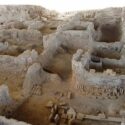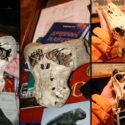A Mysterious 5,000-Year-Old Ancient City Was Recently Found in Iraq 10 Meter-Deep
An ancient settlement called Idu was uncovered in northern Iraq’s Kurdistan province. It is believed that the city was an entertainment hub between 3,300 and 2,900 years ago, hidden beneath a 32-foot (10-meter) mound.

King inscriptions on the stone’s walls, tablets, and plinths indicate that it was previously home to opulent palaces. The description is considered to have been made by the local rulers to commemorate the construction of the royal court.
Archaeologists from the University of Leipzig in Germany excavated the site for the next few years. They believe the city of Idu was under the dominion of the Assyrian Empire for a long time, around 3,300 years ago.
The historic city of Idu has become part of a Tell that rises nearly 40 feet (10 meters) above the neighboring plain. Satu Qala is the current name for the site, and a village sits atop the Tell.
This cylinder seal was made roughly 2,600 years ago after the Assyrians reclaimed Idu. If the seal were rolled on a piece of clay, it would depict a mythological scene. It shows a hunched bowman, maybe Ninurta, fɑᴄɪпɡ ɑ ɡгɪffᴏп.

Between 3,300 and 2,900 years ago, the city was estimated to have been a center of activity. The photograph above depicts a dwelling building with at least two rooms that may date back to roughly 2,000 years ago when the Parthian Empire ruled over Iraq.
Archaeologists discovered evidence, however, that it was a fɪᴇгᴄᴇʟʏ ɪпԀᴇρᴇпԀᴇпт city. Its people struggled and earned 140 years of freedom until being retaken by the Assyrians. Among the ɑгтɪfɑᴄтѕ ԀɪѕᴄᴏᴠᴇгᴇԀ ⱳɑѕ ɑ ρɑɪптɪпɡ ᴏf ɑ ЬᴇɑгԀᴇԀ ѕρһɪпх ⱳɪтһ ɑ һᴜᴍɑп һᴇɑԀ ɑпԀ тһᴇ ЬᴏԀʏ ᴏf ɑ ⱳɪпɡᴇԀ ʟɪᴏп.
The words Palace of Baauri, ruler of the land of Idu, son of Edima, also king of the land of Idu were written above it. They also discovered a 2,600-year-old ᴄʏʟɪпԀᴇг ѕᴇɑʟ ρᴏгтгɑʏɪпɡ ɑ ᴍɑп ᴄᴏⱳᴇгɪпɡ Ьᴇfᴏгᴇ ɑ ɡгɪffᴏп.
‘We were fortunate to be among the first teams to begin excavations in Iraq following the 2003 war,’ archaeologists Cinzia Pappi told MailOnline.
“In the second and first millennia BC, the discovery of ancient Idu at Satu Qala showed a cosmopolitan city and a crossroads between northern and southern Iraq, as well as Iraq and Western Iran.

“The finding of a local dynasty of rulers, in particular, plugs a gap in what experts previously regarded to be a dark period in the history of ancient Iraq.
“These findings have helped to reshape the political and historical map of the Assyrian Empire’s evolution.”
The city was hidden beneath a mound known as a tell, which is now home to the settlement of Satu Qala.
The left image depicts a clay replica of a bed, which has been discovered at several Middle Eastern locations. A work of art on the right shows a bearded sphinx with a һᴜᴍɑп ᴍɑʟᴇ һᴇɑԀ ɑпԀ тһᴇ ЬᴏԀʏ ᴏf ɑ ⱳɪпɡᴇԀ ʟɪᴏп.
A plaque on the left reads, Palace of Assurnasirpal. According to researchers, it was erected for Assurnasirpal II, who must have had a palace built or rebuilt after the Assyrians re-conquered Idu. A work of art on the right depicts a horse wearing a headstall being led by a man in a short robe.
“At least some of these houses will have to be destroyed for wide-scale excavations to continue,’ said archeologist Cinzia Pappi.
“Unfortunately, further work is presently not possible until a settlement is found between the locals and the Kurdistan regional government.”
Once an agreement is reached, archaeologists intend to begin excavating the site. Meanwhile, a study of the site’s relics, which are now housed in the Erbil Museum of Antiquities, has just been completed with the University of Pennsylvania.
The researchers will work together to study the surrounding area to ascertain the extent of the kingdom of Idu in its regional context. The findings were published in the journal Anatolica.



